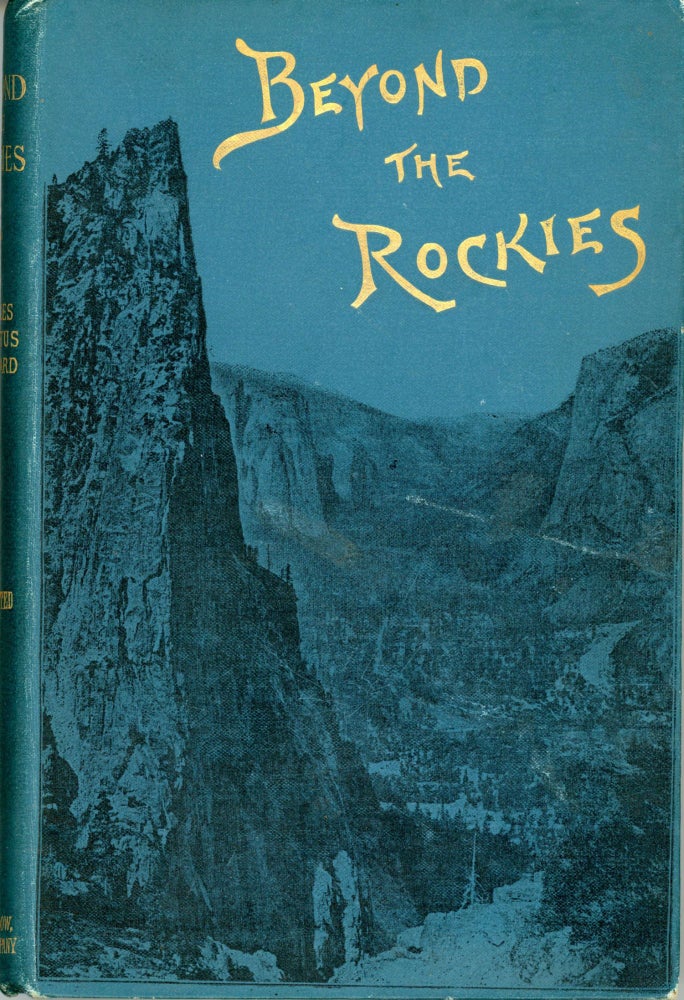Beyond the Rockies a spring journey in California by Charles Augustus Stoddard ... Illustrated. London: Sampson Low, Marston, & Company Limited, St. Dunstan's House, Fetter Lane, Fleet Street, E. C., 1894. 22x13.1 cm, pp. [i-vi] vii-xi [xii] xiii [xiv] 1-214 [215-216: ads] [217-218: blank], 23 inserted plates with photographs by Jackson, Taber and Watkins, original pictorial blue gray cloth, front panel stamped in black and gold, spine panel stamped in gold, top edge gilt, brown coated endpapers. First edition, British issue. Charles Augustus Stoddard (1833-1920), Presbyterian clergyman, journalist and travel writer, was born in Boston but spent most of his life in New York City. He joined the editorial staff of the New York Observer, eventually becoming editor-in-chief and publisher in 1873. His extensive worldwide travel resulted in a number of books recounting his trips alone, with his wife, and others, including Beyond the Rockies: a Spring Journey in California, an account of his trip by train to California with his wife in early 1893. He traveled with "what is known as a 'Raymond' party. This is a conducted party of tourists who travel in a more elegant and comfortable manner than the ordinary parties with which the traveling public is familiar. They have their own train, not crowded or commonplace, they go according to their own schedules, and have all the luxuries which can be furnished on the route at their command. If the hotels are poor, they use their own hotel, which is always first-class, and their tickets and luggage and everything else which impede and irritate the ordinary traveler, are cared for by experienced and agreeable attendants. This is the theory of a 'Raymond' excursion, and I am bound to say that, allowances being made for the accidents of existence, and the frailty of human nature under the best of circumstances, the practice accords fairly well with the theory" (pp. 2-3). The trip to Yosemite Valley and the Mariposa Grove of Big Trees in May 1893, comprises pages 117-136. Lodging in the Yosemite Valley and staging to and from it was largely unpleasant, but the Valley's beauty "will be for memory to rest upon and rejoice in through coming years ..." The travelers were at the mercy of the Yosemite concessionaires for transportation and accommodations, the former controlled by the Washburn brothers, the latter by J. J. Cook, who managed the state hotel, the Stoneman House. "It is pitiful, in the midst of such sublime scenes, to descend to the trivialities of ordinary experience, and think so much of what kind of an ass one can get to ride to the Vernal and Nevada falls, whether there will be enough milk to go around at table, and how many trout will be served at supper ... The hotel was very crowded, there was only one private room with a fireplace, a solitary cow gave all the milk, and the trout had no appreciation of how much they were wanted" (pp. 128-129). The return trip from the Valley to Wawona: "A vision of future misery was before us. There stood the red instrument of torture at the door, with its huge wheels, and awful thorough-braces, well named 'rack,' and falsely named cushions, as hard as excelsior and leather could make them. And there, too, sat the hardened sinner who was to propel this barbarous construction over rock and rut, and log and stone, through bog and snow and flooding rivers, for the next two days. He sat firmly, as if made of cast-iron, with his sceptre, a long-lashed whip, in his hand, ready to beat recalcitrant or despairing beasts into a sense of their duty or a comprehension of their misery. We said farewell to friends, entered the chariot, and climbed the rugged mountain, lingering a moment at Inspiration Point, and then braced ourselves for the unmitigated punishment of the next two days. There was to be one interval of pleasure, in a new sight, and to that we hopefully looked forward. The warm weather and a gang of shovellers had opened the road to the Mariposa 'Big Trees,' and we knew that they were well worth seeing" (pp. 130-131). Of considerable interest is a chapter, "Hetch-Hetchy Valley, pp. 137-142, which prints a letter Stoddard received from John D. Wells, D. D., of Brooklyn, New York, describing a rugged side trip to Hetch-Hetchy Valley in the summer of 1887 by a party of two men and three boys on their way to Yosemite Valley. Not in Cowan (1933). Not in Rocq (1970). Cloth rubbed at spine ends and corner tips, mild spine lean, a very good copy. (#166401).
No statement of printing.


